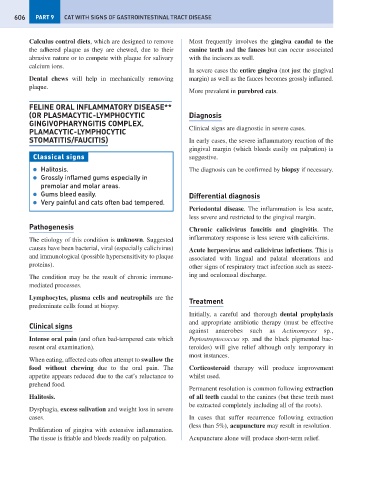Page 614 - Problem-Based Feline Medicine
P. 614
606 PART 9 CAT WITH SIGNS OF GASTROINTESTINAL TRACT DISEASE
Calculus control diets, which are designed to remove Most frequently involves the gingiva caudal to the
the adhered plaque as they are chewed, due to their canine teeth and the fauces but can occur associated
abrasive nature or to compete with plaque for salivary with the incisors as well.
calcium ions.
In severe cases the entire gingiva (not just the gingival
Dental chews will help in mechanically removing margin) as well as the fauces becomes grossly inflamed.
plaque.
More prevalent in purebred cats.
FELINE ORAL INFLAMMATORY DISEASE**
(OR PLASMACYTIC-LYMPHOCYTIC Diagnosis
GINGIVOPHARYNGITIS COMPLEX,
PLAMACYTIC-LYMPHOCYTIC Clinical signs are diagnostic in severe cases.
STOMATITIS/FAUCITIS) In early cases, the severe inflammatory reaction of the
gingival margin (which bleeds easily on palpation) is
Classical signs suggestive.
● Halitosis. The diagnosis can be confirmed by biopsy if necessary.
● Grossly inflamed gums especially in
premolar and molar areas.
● Gums bleed easily. Differential diagnosis
● Very painful and cats often bad tempered.
Periodontal disease. The inflammation is less acute,
less severe and restricted to the gingival margin.
Pathogenesis Chronic calicivirus faucitis and gingivitis. The
The etiology of this condition is unknown. Suggested inflammatory response is less severe with calicivirus.
causes have been bacterial, viral (especially calicivirus) Acute herpesvirus and calicivirus infections. This is
and immunological (possible hypersensitivity to plaque associated with lingual and palatal ulcerations and
proteins). other signs of respiratory tract infection such as sneez-
The condition may be the result of chronic immune- ing and oculonasal discharge.
mediated processes.
Lymphocytes, plasma cells and neutrophils are the
Treatment
predominate cells found at biopsy.
Initially, a careful and thorough dental prophylaxis
and appropriate antibiotic therapy (must be effective
Clinical signs
against anaerobes such as Actinomyces sp.,
Intense oral pain (and often bad-tempered cats which Peptostreptococcus sp. and the black pigmented bac-
resent oral examination). teroides) will give relief although only temporary in
most instances.
When eating, affected cats often attempt to swallow the
food without chewing due to the oral pain. The Corticosteroid therapy will produce improvement
appetite appears reduced due to the cat’s reluctance to whilst used.
prehend food.
Permanent resolution is common following extraction
Halitosis. of all teeth caudal to the canines (but these teeth must
be extracted completely including all of the roots).
Dysphagia, excess salivation and weight loss in severe
cases. In cases that suffer recurrence following extraction
(less than 5%), acupuncture may result in resolution.
Proliferation of gingiva with extensive inflammation.
The tissue is friable and bleeds readily on palpation. Acupuncture alone will produce short-term relief.

